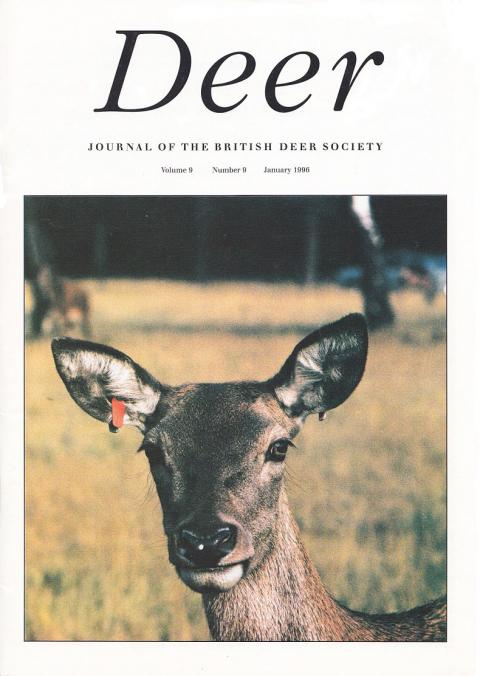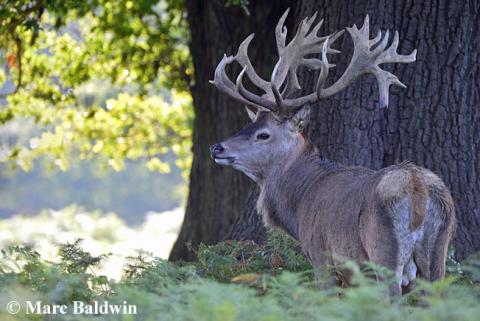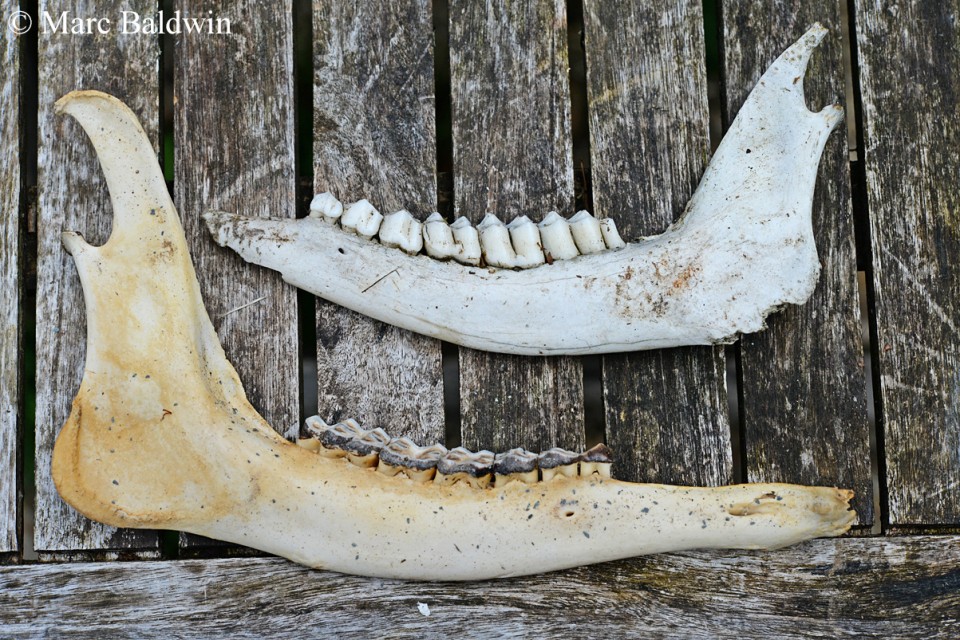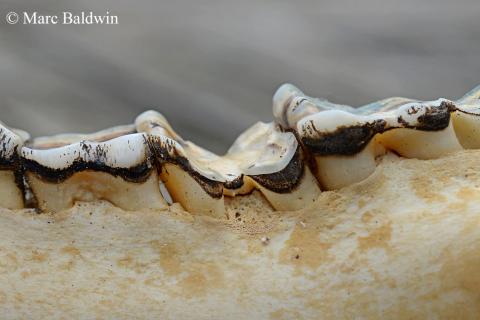Red Deer Ageing & Longevity
There are various myths involving long-lived stags. Perhaps the most famous is a Gaelic proverb that, according to John Fletcher in his A Life for Deer, can be traced back to the Greek poet Hesiod and is inscribed on the mediaeval pavement in front of the high alter at Westminster:
Thrice the age of a dog, the age of a horse;
Thrice the age of a horse, the age of a man;
Thrice the age of a man, the age of a deer;
Thrice the age of a deer, the age of an eagle;
Thrice the age of an eagle, the age of an oak tree.
Assuming a generous estimate for “old age” during the Iron Age, this would put “the age of a deer” at about 120 years old. Equally, even if the proverb was written by Hesiod, who many scholars believe lived during the eighth century BC, we still arrive at an impressive age of 90 years for the deer. As one might expect, modern day estimates don't come anywhere close to these values.

Growing old gracefully
According to Frankfurt Zoo biologist Richard Weigl’s Longevity of Mammals in Captivity, the oldest Red deer on record is a female (listed as subspecies sibiricus) who was born at Kiev Zoo in July 1968 and died in January 2000 at the ripe old age of 31 years and six months. Weigl published longevity records for 20 subspecies of Cervus elaphus in his 2005 book - the record for the subspecies elaphus stands at 21 years and 4 months, while that for scoticus is held by a female born at Washington Park Zoo during October 1927 that died in June 1954 at the age of 26 years and eight months. Interestingly, Weigl doesn't mention “Bambi”, a hand-reared hind owned by the Fraser family from Kiltarlity in the Scottish Highlands who, according to The Guinness Book of World Records, died in January 1995 at the grand age of of 31 years 7 months, or a hind, nicknamed “the old lady of Richmond Park”, who apparently survived to 27 years old.
Despite these rather impressive figures, these are all ages for captive deer and the maximum age that an animal can reach in captivity (with plenty of food, no predators, veterinary care etc.) is often a far cry from the maximum age attainable in the wild. A cursory inspection of the literature suggests that the oldest wild hinds attain about 25 years old, while stags reach about 18 years old. Arguably, reaching 25 in the wild is the exception rather than the rule; indeed, records of wild hinds living beyond 15 years and stags beyond 12 years are rare.
Overall, the demographic data from the population of Red deer on the Scottish island of Rum suggest that few specimens live longer than about eight years. In her 1991 book, Deer, Norma Chapman pointed out that some researchers have estimated that 50% of Scottish Red deer attain an average age of four years, while only 25% reach eight-years-old. Interestingly though, in volume three of his Mammals of Great Britain and Ireland (published in 1906), English naturalist and travel writer John Guille Millais wrote that Red stags reach their prime at about 11 years old and remain at this 'peak' for another four or five years.
Looking your age?
Ageing with antlers

Ageing Red deer from their physical appearance is not an easy task. There are many features that experienced stalkers may use to assess age—for example body size, head length, time of moult, antler casting, and various aspects of antler morphology—but, as Rory Putman pointed out in his 2005 report for the Deer Commission for Scotland:
“None of these factors however shows linear correlation with age. Thus indicators used may be sufficient simply for categorical distinction between discrete age classes rather than as indicators of precise age.”
Indeed, most books on deer make reference, at some point, to it being a common misconception that you can age a deer by counting the points on its antlers - while the general pattern of antler development seems to be 'genetically fixed' there are other factors (most notably food quality) that can influence the final arrangement. Nonetheless, this doesn't mean that we shouldn't look at antlers in a bid to estimate age. Indeed, in their contribution to Mammals of the British Isles, Brian Staines, Jochen Langbein and Tim Burkitt note that, while antler size per se is a poor indicator of age, beam width, coronet breadth and height of the coronet above the skull are good indicators.
Long in the tooth?
Obviously, antler morphology is only of any benefit during certain seasons, and if the animal you're trying to age is a male, even then there can still be some ambiguity associated with antler measurements. Consequently, biologists turned their attention to teeth. When using dentition to infer age we are immediately confronted with the problem that, contrary to popular misconception, it is difficult to reliably tell the age of an animal from tooth wear, and tooth eruption is of limited use. Tooth eruption is generally only helpful for young animals (up to the age they obtain their permanent dentition). Indeed, in a 2002 paper to the journal Anales de Biologia, a group of Spanish biologists report their findings from a detailed study of the tooth eruption pattern in Red deer from Sierra Morena in southern Spain. The researchers concluded that, despite some difficulties (including delays in the replacement and eruption of some teeth), it is possible to determine age in this species up to three-and-a-half years old by studying gradual changes in the teeth.
In a 2003 paper, three of the same Spanish researchers found that whether or not the mandible (lower jaw bone) is fully grown may also point to the deer's age, with female mandibles being fully developed at around 55 months (4.5 years) and males complete at about 80 months (6.5 years), although this requires the deer to be dead in order to confirm. A similar study in Norway yielded similar results; in a huge sample of more than 40,000 Red deer it was found that there was a distinct relationship between mandibular proportions and age, but this decreased with age and the relationship between mandible size and weight was almost flat by the age of five years.
In her 1991 book, Deer, Norma Chapman noted that studies of captive Red and Fallow deer found that it was possible to age the animals based on the level of wear on and between each slope of each molar, with the total score giving the deer's age. Indeed, based on his studies of the Red deer population of Rum, Victor Lowe wrote in a 1967 paper to the Journal of Zoology that:
“88% of the marked deer up to the age of 8 years could be reliably aged from tooth replacement, eruption and wear”.

Despite Lowe's success, the amount of wear on teeth is typically a poor indicator of age, because the rate at which teeth wear down is almost exclusively a result of the animal's diet - there are some other contributing factors (tooth topography and genetically controlled tooth mineralisation, for example) but it generally holds that the coarser the diet, the quicker the teeth wear. Thus, two populations of the same species could easily display different degrees of tooth wear if they're feeding on a different diet. Moreover, work by Leif Loe at the University Center in Svalbard in Norway, between 1971 and 2001, suggests that tooth wear actually decreases with age in Red deer.
In a 2003 paper to the journal Oecologia, Loe and his colleagues present data on tooth wear for 2,659 Red deer (roughly evenly split between the sexes) between three and 25 years old. The zoologists found that the rate of tooth wear declined with age such that four year old stags wore down their molars at about 0.61 mm per year (0.024 in.), while stags at 11 years old displayed wear rates of only 0.45 mm per year (0.018 in.). Rates of wear were slightly lower in females, with four and 11 year old hinds experiencing 0.52 mm (0.020 in.) and 0.39 mm (0.015), respectively. The authors suggest that this difference in rate of wear between the sexes is a result of a difference in diet selection, with males feeding on a lower quality diet than females. Indeed, it has now been well established that many grasses have granular structures called phytoliths, of various sizes and shapes, made of silica on the surface of their leaves - these phytoliths are hard and sharp (this is why you can cut yourself on grass) and cause considerable wear on the teeth of herbivores.

Given the problems associated with inferring age from tooth eruption or wear, during the 1960s, scientists came up with the idea of looking inside the teeth. More specifically, they discovered that you could get a pretty good idea of a deer's age if you sectioned a tooth and counted the annuli ('rings') in its root - this is known as the cementum method of ageing. The biochemistry that governs the deposition of annuli is rather complex, but essentially it appears that deer are low in blood-serum protein and phosphate during the winter months, which leads to improper calcification of the tooth's cementum. This poorly calcified, narrow layer (sometimes referred to as a 'rest line') shows up as a darker band in the tooth and there should be one such band present for each winter through which the deer has lived.
In a 2004 paper to the Wildlife Society Bulletin, the same Spanish biologists—who published their data on Spanish Red deer tooth eruption and mandible growth—report on the efficiency of ageing deer by using growth marks in their teeth. The researchers found that molars provided the most accurate ages, correctly ageing 75% of their animals, while only 49% of age estimates made from incisors were correct. However, when the scientists widened the goal posts a little, increasing the confidence limit to one year (i.e. the estimate could be either a year over or under the actual age), they found that molars and incisors could be used to accurately age 99% and 86% of the animals, respectively. Interestingly, the researchers found that the first 'rest line' was deposited in the molar at six months old, while it didn't appear in the incisor until the animal was 15 months old, so additional caution may be necessary when interpreting ring data from incisors.
Studies on White-tailed (Odocoileus virginianus) and Mule deer (O. hemionus) by American biologists have suggested that it is possible to age deer fawns based on the wear on their hooves. While this method seems fairly reliable on captive fawns, however, much like tooth wear, it is tempting to think that there are a considerable number of factors that can influence this characteristic and this may cause confusion when applied to wild animals.
Acting your age

Before we leave the subject of age in deer, let us briefly touch upon the fascinating phenomenon of ageing rate, described as “dramatic and sudden” in an article on the BBC News website during August 2009. In a paper to the journal The American Naturalist, a team of biologists led by Edinburgh University's Dan Nussey reported 40 years' worth of data on senescence (i.e. the signs of getting old) in Red deer from the Isle of Rum. The biologists uncovered a complex pattern in which the signs of old age appear at different times, with significant differences between stags and hinds.
Nussey and his team found that, although stags seemed perfectly capable of growing and maintaining antlers into their twilight years, those more than about 10 years old rapidly became less successful at rutting and typically fathered fewer calves - there are, of course, exceptions here and fans of the BBC's AutumnWatch will probably recall that a Red stag named Percy won their '2009 rut award' after being seen to mate with more hinds than any other stag, despite being 14 years old. Similarly interesting data were presented for females, which seem to start showing signs of old age at around nine years old. It appears that, despite starting to “look older”, hinds were able to successfully calf well into their teens and even females that were considered “past their prime” were observed to continue breeding, although their offspring were typically smaller and thus less likely to survive their first winter than those of younger hinds.
In addition to markedly different patterns of ageing between the sexes, Red deer also appear to have a rate of senescence that is heavily influenced by their early life conditions, especially the number of other deer around. In a fascinating paper to the journal Current Biology during 2007, biologists from Edinburgh and Cambridge Universities, again led by Dan Nussey reported that:
“… females experiencing high levels of resource competition during early life showed faster rates of senescence as adults.”
Basically, more deer means greater competition for resources and Red deer hinds effectively age more rapidly when food is scarce. Additionally, the researchers found that the likelihood of a female producing a calf declined more quickly with old age in hinds that experienced harsh conditions early in life. Hinds that were born later as a result of their mother being exposed to harsh conditions were found to start breeding later than those born to hinds breeding during favourable conditions.
Overall, while there are methods by which we can establish the age of a Red deer, it is always worth bearing in mind that the phenomenon of ageing and senescence is complex and, in hinds at least, appears very closely tied not only to the conditions in which she lives, but also those experienced by her mother early in life.